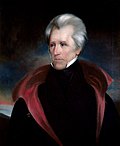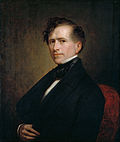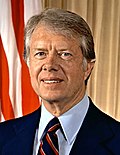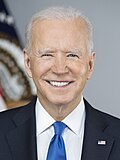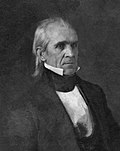Democratic Party (United States)
The Democratic Party, also known as the Democrats, is one of the two biggest political parties in the United States. Since the mid-1850's, the party's main opponent has been the Republican Party. Both political parties have controlled American politics ever since.
 | |
| Senate Minority Leader | Chuck Schumer |
| House Minority Leader | Hakeem Jeffries |
| Preceded by | Democratic-Republican Party |
| Headquarters | 430 South Capitol St. SE, Washington, D.C., U.S. |
| Student wing | |
| Youth wing | Young Democrats of America |
| Women's wing | National Federation of Democratic Women |
| Overseas wing | Democrats Abroad |
| Ideology | |
| Political position | Center-leftA[›][16] |
| Caucuses | Blue Dog Coalition New Democrat Coalition Congressional Progressive Caucus |
| Colors | Blue |
| Senate | 45 / 100[a] |
| House of Representatives | 213 / 435 |
| State governors | 23 / 50 |
| State upper chambers | 832 / 1,973 |
| State lower chambers | 2,385 / 5,413 |
| Territorial governors | 2 / 5 |
| Seats in Territorial upper chambers | 21 / 97 |
| Seats in Territorial lower chambers | 9 / 91 |
| Election symbol | |
 | |
| Website | |
{{URL|example.com|optional display text}} | |
^ A: The Oxford Companion to American Politics observes that the terms "progressive" and "liberal" are "often used interchangeably" in political discourse regarding "the center-left".[17] | |
Overview
The party sits at the center to center-left of the American political spectrum, with the Republican Party being positioned to their right.
Every four years, the party holds a National Convention where they agree on their candidate for president. The Democratic National Committee coordinates most of the activities of the Democratic Party in all 50 United States. Since Andrew Jackson's inauguration in 1829, there have been 16 Democratic presidents. The most recent is Joe Biden who took office as the 46th president of the United States in January 2021. The Democratic Party represents a broad spectrum of liberal and left-wing ideologies, including but not limited to classical liberalism, social democracy, progressivism, and social modern liberalism.
Philosophy
Democrats, also sometimes called the left, liberals or progressives make up one of the two main political parties in the United States. A mostly Democratic state is sometimes called a blue state. This comes from the party’s main color, which is blue, referring to a state supporting "blue" candidates.
Role of government
Democrats believe in a strong government with social assistance programs to help members of society. They prefer diplomatic solutions to conflicts, and take generally multilateralist views on trade, believing that trade must be free, but fair to protect American workers, consumers, local communities, and the environment. Some Democrats are economic centrists.[21][22]
Social issues
Socially, most Democrats believe in sociocultural liberalism, taking pro-immigration, pro-marriage equality, and pro-choice views.[23]
Beliefs
Currently, the Democratic Party is identified by progressivism, liberalism, and left-wing policies. Not all Democrats hold the same beliefs, but generally these are the things many Democrats support:
- Progressive income tax
- Higher corporate taxes and recapturing income from overseas profits
- Spending on business, education, infrastructure and clean energy
- Expanding spending on government programs
- Ending the death penalty
- Expanding rights to abortion
- Gun regulations to prevent citizens from hurting themselves and others with firearms
- Universal healthcare
- Declare Washington D.C. an official state
- Helping students go to college or university for free without having to pay back the government
- Believe in allowing undocumented immigrants to work for their U.S Citizenship in the U.S. to stay, pay taxes, and oppose mass deportation
Most support for Democrats comes from states in the Northeast, Upper Midwest, and the Pacific Coast, as well as from the state of Hawaii.
Symbols
The symbol of the Democratic Party is the donkey.[24] Since the election of 2000, the color blue has become a symbol for Democrats.[25]
Historically, Thomas Jefferson, whom the party claims as its founder, has been often seen as symbols of the Democratic Party, particularly emphasized in the annual celebrations of Jefferson Day Dinners held since the days of Andrew Jackson. As such, the Democratic Party is also often referred to as the “Party of Jefferson.”[26]
List of Democratic presidents
Select list of Democratic politicians
- Kamala Harris (California), Vice President and U.S. Senator from California
- John Kerry (Massachusetts), former Secretary of State, former Senator, former presidential nominee
- Patrick Leahy (Vermont), former President Pro Tempore, Senator, and Dean of the Senate
- Hillary Clinton (New York), former Secretary of State, former Senator, former First Lady, former presidential nominee
- Jim Clyburn (South Carolina), Representative and Assistant Democratic Leader
- Howard Dean (Vermont), former Governor and former head of the Democratic National Committee, former presidential nominee
- Christopher Dodd (Connecticut), former Senator
- Mario Cuomo (New York), former Governor
- Dick Durbin (Illinois), Senate Whip
- George Moscone (California), former Mayor of San Francisco
- Chuck Schumer (New York), Senator, former Senate Majority Leader
- Harvey Milk (California), Member of the San Francisco Board of Supervisors
- William M. Daley (Illinois), candidate for Governor of Illinois, former White House Chief of Staff
- Frank Lautenberg (New Jersey), former Senator
- Pat Quinn, Governor of Illinois
- Paul Simon (Illinois), former Senator
- Arlen Specter (Pennsylvania), former Senator
- Bob Menendez (New Jersey), Senator
- Richard M. Daley (Illinois), former Mayor of Chicago
- Richard J. Daley (Illinois), former Mayor of Chicago
- Al Gore (Tennessee), former presidential candidate and vice-president
- John F. Kennedy, former President (Massachusetts)
- Robert F. Kennedy, former Senator, former presidential candidate, and brother of John F. Kennedy
- Daniel Inouye (Hawaii), former President Pro Tempore, former Senator, and former Dean of the Senate
- Steny Hoyer (Maryland), House Minority Whip
- Robert Byrd (West Virginia), former President Pro Tempore, former Senator, and former Dean of the Senate
- Tim Kaine (Virginia), Governor, 2016 vice presidential nominee and former head of the Democratic National Committee
- Dennis Kucinich (Ohio), Representative
- Janet Napolitano (Arizona), Secretary of Homeland Security
- Nancy Pelosi (California), Speaker of the House, former Speaker of the House.
- Brian Schweitzer (Montana), former Governor
- Harry Reid (Nevada), former Senate Minority Leader, former Majority Leader
- Rahm Emanuel (Illinois), Mayor of Chicago, former White House Chief of Staff
- Harry F. Byrd, Jr. (Virginia), former Senator
- Bill Richardson (New Mexico), Governor
- Debbie Wasserman Schultz (Florida), Representative and former head of the Democratic National Committee
- Mark Warner (Virginia), Senator and former Governor
- Elizabeth Warren, Senator from Massachusetts
- Alexandria Ocasio-Cortez (New York), Representative
- Hakeem Jeffries, House Minority Leader
Independents who work with Democrats
- Bernie Sanders, Senator from Vermont
- Angus King, Senator from Maine
List of former Democrats
- Ronald Reagan (California), 40th president of the United States (1981–1989). Registered Democrat until 1962.
- Condoleezza Rice (Alabama), 66th United States Secretary of State (2005–2009). Registered Democrat until 1982.
- Rudy Giuliani (New York), 107th Mayor of New York City (1994–2001). Registered Democrat until 1975.
- Rick Perry (Texas), 14th United States Secretary of Energy (2017–2019), 47th Governor of Texas (2000–2015). Registered Democrat until 1989.
- Jesse Helms (North Carolina), United States Senator (1973–2003). Registered Democrat (1942–1970).
- Donald Trump (New York), 45th and 47th President of the United States (2017–2021), (2025–present) Registered Democrat on and off until 2009.[27]
Democratic Party (United States) Media
Andrew Jackson was the seventh president (1829–1837) and the first Democratic president.
Martin Van Buren was the eighth president (1837–1841).
James K. Polk was the 11th president (1845–1849). He significantly extended the territory of the United States.
Stephen A. Douglas was a United States senator for Illinois.
Leaders of the Democratic Party during the first half of the 20th century on in 1913: William Jennings Bryan, Josephus Daniels, Woodrow Wilson, Breckinridge Long, William Phillips, and Franklin D. Roosevelt
Franklin D. Roosevelt and Harry S. Truman, the 32nd and 33rd presidents (1933–1945; 1945–1953), featured on a campaign poster for the 1944 presidential election; note the rooster logo of the Democratic Party (see Names and Symbols below)
Jimmy Carter, the 39th president (1977–1981)
Related pages
References
- ↑ Arnold, N. Scott (2009). Imposing values: an essay on liberalism and regulation. Oxford University Press. p. 3. ISBN 9780495501121. Archived from the original on October 2, 2020. Retrieved April 28, 2020.
Modern liberalism occupies the left-of-center in the traditional political spectrum and is represented by the Democratic Party in the United States.
- ↑ Geismer, Lily (2015). Don't blame us: suburban liberals and the transformation of the Democratic party. Politics and society in twentieth-century America. Princeton: Princeton University Press. ISBN 978-0-691-15723-8.
- ↑ Cebul, Brent; Geismer, Lily, eds. (2025). Mastery and drift: professional-class liberals since the 1960s. Chicago: The University of Chicago Press. ISBN 978-0-226-83811-3.
- ↑ Bacon, Perry Jr. (March 11, 2019). "The Six Wings Of The Democratic Party". FiveThirtyEight. https://fivethirtyeight.com/features/the-six-wings-of-the-democratic-party/. Retrieved October 21, 2021.
- ↑ Levitz, Eric (2018-10-18). "America Already Has a Centrist Party. It's Called the Democrats". Intelligencer. Retrieved 2024-10-02.
- ↑ Ball, Molly (February 7, 2014). "No, Liberals Don't Control the Democratic Party". The Atlantic. Retrieved 13 March 2017.
- ↑ Gaudiano, Nicole. "Liberals seek 'ideological shift' in the Democratic Party". USA Today. Gannett Satellite Information Network, LLC. Retrieved 13 March 2017.
- ↑ Alterman, Eric (2008). Why We're Liberals: A Political Handbook for Post-Bush America. Penguin. p. 339. ISBN 9780670018604. Retrieved 13 March 2017.
Suffice to say that there has not been a huge swing away from the center since the 1970s.
- ↑ [4][5][6][7][8]
- ↑ Stein, Letita; Cornwell, Susan; Tanfani, Joseph (August 23, 2018). "Inside the progressive movement roiling the Democratic Party". Reuters. https://www.reuters.com/article/us-usa-election-progressives-specialrepo/inside-the-progressive-movement-roiling-the-democratic-party-idUSKCN1L81GI. Retrieved June 13, 2022.
- ↑ Rae, Nicol C. (June 2007). "Be Careful What You Wish For: The Rise of Responsible Parties in American National Politics". Annual Review of Political Science. Annual Reviews. 10 (1): 169–191. doi:10.1146/annurev.polisci.10.071105.100750. ISSN 1094-2939.
What are we to make of American parties at the dawn of the twenty-first century? ... The impact of the 1960s civil rights revolution has been to create two more ideologically coherent parties: a generally liberal or center-left party and a conservative party.
- ↑ Cronin, James E.; Ross, George W.; Shoch, James (August 24, 2011). "Introduction: The New World of the Center-Left". What's Left of the Left: Democrats and Social Democrats in Challenging Times. Duke University Press. ISBN 978-0-8223-5079-8. Archived from the original on August 20, 2024. Retrieved August 7, 2024. pp. 17, 22, 182:
Including the American Democratic Party in a comparative analysis of center-left parties is unorthodox, since unlike Europe, America has not produced a socialist movement tied to a strong union movement. Yet the Democrats may have become center-left before anyone else, obliged by their different historical trajectory to build complex alliances with social groups other than the working class and to deal with unusually powerful capitalists ... Taken together, the three chapters devoted to the United States show that the center-left in America faces much the same set of problems as elsewhere and, especially in light of the election results from 2008, that the Democratic Party's potential to win elections, despite its current slide in approval, may be at least equal to that of any center-left party in Europe ... Despite the setback in the 2010 midterms, together the foregoing trends have put the Democrats in a position to eventually build a dominant center-left majority in the United States.
- ↑ Bruner, Christopher (January 1, 2018). "Center-Left Politics and Corporate Governance: What Is the 'Progressive' Agenda?". Brigham Young University Law Review: 267–338.
While these dynamics have remained have remained important to the Democratic Party's electoral strategy since the 1990s, the finance-driven coalition described above remains high controverisal and unstable, reflecting the fact that core intellectual and ideological tensions in the platform of the U.S. center-left persist.
- ↑ Hacker, Jacob S.; Malpas, Amelia; Pierson, Paul; Zacher, Sam (December 27, 2023). "Bridging the Blue Divide: The Democrats' New Metro Coalition and the Unexpected Prominence of Redistribution". Perspectives on Politics. Cambridge University Press on behalf of the American Political Science Association. 22 (3): 3. doi:10.1017/S1537592723002931. ISSN 1537-5927.
We conclude by considering why Democrats have taken this course, why they are not perceived as having done so, and why, at this fraught juncture for American democratic capitalism, political scientists could learn much from closer examination of the rich world's largest center-left party.
- ↑ Zacher, Sam (June 2024). "Polarization of the Rich: The New Democratic Allegiance of Affluent Americans and the Politics of Redistribution". Perspectives on Politics. 22 (2): 338–356. doi:10.1017/S1537592722003310.
It is clear that the Democratic Party—the center-left United States political party—does enact some forms of a redistributive economic policy agenda.
- ↑ [11][12][13][14][15]
- ↑ Coates, David, ed. (2012). "Liberalism, Center-left". The Oxford Companion to American Politics. Oxford University Press. pp. 68–69. doi:10.1093/acref/9780199764310.001.0001. ISBN 978-0-19-976431-0.
- ↑ Cole, Donald B. (1970). Jacksonian Democracy in New Hampshire, 1800–1851. Harvard University Press. p. 69. ISBN 978-0-67-428368-8.
- ↑ About the Democratic Party. March 4, 2019. https://democrats.org/who-we-are/about-the-democratic-party/. Retrieved April 15, 2022. "For 171 years, [the Democratic National Committee] has been responsible for governing the Democratic Party".
- ↑ Democratic Party (Sep 10, 2022). "The Charter & The Bylaws of the Democratic Party of the United States" (PDF). p. 3. Archived (PDF) from the original on Jan 22, 2025. Retrieved March 24, 2025.
The Democratic National Committee shall have general responsibility for the affairs of the Democratic Party between National Conventions
- ↑ Gould, Joe (2021-05-13). "Bernie Sanders wants to cut defense spending. Not all Democrats agree". Defense News. Retrieved 2021-05-14.
- ↑ (in en-US) Biden's sweeping — and fluid — tax plans are making some congressional Democrats nervous. . https://www.washingtonpost.com/us-policy/2021/05/11/biden-taxes-democrats/. Retrieved 2021-05-14.
- ↑ * Paul Starr. "Center-Left Liberalism". Princeton University. Archived from the original on March 3, 2015. Retrieved June 9, 2014.
- Frumin, Aliyah (November 25, 2013). Obama: 'Long past time' for immigration reform. MSNBC.com. https://msnbc.com/hardball/obama-long-past-time-reform. Retrieved January 26, 2014.
- Changing Views on Social Issues. April 30, 2009. https://abcnews.go.com/images/PollingUnit/1089a6HotButtonIssues.pdf. Retrieved May 14, 2009.
- "Pew Research Center. (May 10, 2005). Beyond Red vs. Blue, p. 1 of 8". May 10, 2005. Archived from the original on July 8, 2012. Retrieved July 12, 2007.
- ↑ see "History of the Democratic Donkey"
- ↑ Farhi, Paul (November 2, 2004). Elephants Are Red, Donkeys Are Blue. p. C01. https://www.washingtonpost.com/wp-dyn/articles/A17079-2004Nov1.html. Retrieved October 11, 2016.
- ↑ Trotter, Bill (February 11, 2008). Obama sets sights on November battle. Archived from the original on February 28, 2008. https://web.archive.org/web/20080228050855/http://www.bangornews.com/news/t/city.aspx?articleid=160039&zoneid=176. Retrieved February 12, 2008.
- ↑ Tom Murse (July 20, 2019). "Was Donald Trump a Democrat?". ThoughtCo. Retrieved September 13, 2019.
- ↑ There are 45 senators who are members of the party; however, two independent senators, Angus King and Bernie Sanders, caucus with the Democrats.
- ↑ Elected as Vice President with the National Union Party ticket in the 1864 presidential election. Ascended to the presidency after the assassination of President Abraham Lincoln in 1865. Rejoined the Democratic Party in 1868.
- ↑ 3.0 3.1 Died in office.
Other websites
| Wikimedia Commons has media related to Lua error in Module:Commons_link at line 62: attempt to index field 'wikibase' (a nil value).. |
